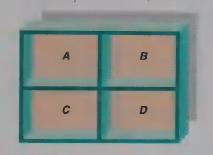8. The grid shown here is an initial layout of four square departments within a square office...
Question:
8. The grid shown here is an initial layout of four square departments within a square office building. The number of moves each week between departments is as follows:
A—B = 200, A-C = 300, A—D = 400, B—C = 200, B—D = 500, C—D = 100. All movements are assumed to occur from the center of the sending departments to the center of the receiving departments. These moves are made along aisles that run parallel to the exterior walls. Therefore the average move distance between diagonally located departments is assumed to be 200 feet, and between adjacent departments it is assumed to be 100 feet. Enumerate the layouts that can be made through pairwise interchanges, and determine the total movement distance that results from each layout.
Which layout minimizes movement?

Step by Step Answer:

Operations Management Providing Value In Goods And Services
ISBN: 9780030262074
3rd Edition
Authors: Dilworth, James B





